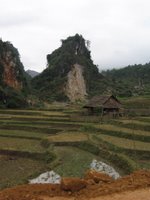Heaven's Gate
 One of my regrets from our 2003 trip to Vietnam was that we never got to the Northern highlands. We had considered it but by then it was late December and too cold in the mountains. A week and a half ago my parents left and the weather was still warm, so I booked a three day mountain biking trip running a loop from Sapa over the Tram Tom (Heaven's Gate) pass and back to Lao Cai on the border with China through the remote highlands of the Tonkinese Alps. This region is largely populated by pastoral hill tribes who possess their own distinct cultures and languages and are identifiable by their unique and beautiful dress.
One of my regrets from our 2003 trip to Vietnam was that we never got to the Northern highlands. We had considered it but by then it was late December and too cold in the mountains. A week and a half ago my parents left and the weather was still warm, so I booked a three day mountain biking trip running a loop from Sapa over the Tram Tom (Heaven's Gate) pass and back to Lao Cai on the border with China through the remote highlands of the Tonkinese Alps. This region is largely populated by pastoral hill tribes who possess their own distinct cultures and languages and are identifiable by their unique and beautiful dress.Two days after I booked the trip, winter arrived quite abruptly in the North and I worried that I had consigned myself to a wet, cold and miserable weekend completely socked in by fog. I spent a week shopping for warm clothes in Hanoi to prepare. In fact, the weather was surprisingly decent (even a half day of bright blue skies) and accommodated vast mountain panoramas that filled up half the sky. Yes, not what what people think of when they try to imagine tropical Vietnam.
Our little biking group gathered in Sapa after an overnight train from Hanoi. The cast of characters: me; a young American water engineer working in Sri Lanka; Nam, the driver of our 1978 Russian jeep; and Tu, our guide.
Tu was able to give us the inside scoop on hill tribe life since he is himself of the Tay minority from a village in the remote Northeast. He spoke impeccable English and claimed to be entirely self-taught. He was one of the few to venture out of his traditional village to the big city to make his way. Initially he went to Hanoi to study, but his education was aborted and instead he found himself shining shoes and selling postcards at the side of Hoan Kiem Lake. Usually stories like this do not turn out pretty. Many of these vendors are desperate and hardened by the street, and most were swept away and sent back to the countryside several years ago during a crackdown. Remarkably it seems Tu escaped this fate. Instead he learned enough English by talking (and selling) to foreigners to get himself hired by one of the most reputable tour operators. I admire his chutzpah.
I did not get to know our driver Nam well because of the language barrier but he seemed to appreciate my little attempts to speak to him in Vietnamese and rewarded my efforts by continually offering me rounds of rice wine at lunch (admittedly not the greatest pastime for a driver).
 The tour took us through over the Hoang Lien mountain range (though the highest peak in Vietnam, Fansipan was cloaked in fog) and then down through spectacular paddy terraced valleys dotted with the traditional villages of the Hmong, Red Dao, Lu, White Thai, Black Thai, and Tay peoples. The tour company assured me that this tour gets you deep into the countryside to areas infrequently visited by outsiders. I did not appreciate the truth of this until we later compared notes with other travellers who had been trekking and who complained about the constant sell job they received by villagers used to the allure of the tourist dollar (even on what they thought were remote mountain pathways). In contrast, only once in three days did we have anyone try to sell us anything. Instead we encountered what must be some of the friendliest people on earth. At every bend in the road, at every little village and thatched house we encountered overwhelming goodwill. Everywhere children giggled and called out to us with staccato "hellos" from all directions, from villagers along the road and sometimes even from distant voices from locations unseen. Even though the countryside is sparsely populated, there were often too many excited hellos to acknowledge, and yet we would feel guilty if we failed to respond to each one. The kids would get such a kick out of it and would erupt into giddy laughter. On occasion the kids would hop on their bikes and race us down the road.
The tour took us through over the Hoang Lien mountain range (though the highest peak in Vietnam, Fansipan was cloaked in fog) and then down through spectacular paddy terraced valleys dotted with the traditional villages of the Hmong, Red Dao, Lu, White Thai, Black Thai, and Tay peoples. The tour company assured me that this tour gets you deep into the countryside to areas infrequently visited by outsiders. I did not appreciate the truth of this until we later compared notes with other travellers who had been trekking and who complained about the constant sell job they received by villagers used to the allure of the tourist dollar (even on what they thought were remote mountain pathways). In contrast, only once in three days did we have anyone try to sell us anything. Instead we encountered what must be some of the friendliest people on earth. At every bend in the road, at every little village and thatched house we encountered overwhelming goodwill. Everywhere children giggled and called out to us with staccato "hellos" from all directions, from villagers along the road and sometimes even from distant voices from locations unseen. Even though the countryside is sparsely populated, there were often too many excited hellos to acknowledge, and yet we would feel guilty if we failed to respond to each one. The kids would get such a kick out of it and would erupt into giddy laughter. On occasion the kids would hop on their bikes and race us down the road.At one point we leaned our bikes up against a tree at the side of the road and wandered down a path into the fields to see traditional White Thai burial shelters. Three young men came upon us as our guide was explaining local burial practices. In wordless unison they squatted next to us and watched in fascination as we talked. They looked stoic but when we smiled at them their blank expressions transformed into huge broad smiles. Eventually we returned to the road and found that at least half a village had emerged to inspect our bikes. They gawked, giggled and stared at us, but always in the most hospitable way.
 Another time we took a slight detour to inspect the view from a narrow suspension bridge over a river. When we looked back from the middle of the bridge we saw about 30 people coming to check us out. Half of them were curious goofy little kids. They rushed in to gather round us. Thank God for display panels on digital cameras which are endlessly entertaining to kids. The children would gasp and break into hysterical laughter when they'd see themselves on the little screen.
Another time we took a slight detour to inspect the view from a narrow suspension bridge over a river. When we looked back from the middle of the bridge we saw about 30 people coming to check us out. Half of them were curious goofy little kids. They rushed in to gather round us. Thank God for display panels on digital cameras which are endlessly entertaining to kids. The children would gasp and break into hysterical laughter when they'd see themselves on the little screen.We made two visits to stilt homes during our trip. On our first full day cycling, we took a very muddy turn off the main road to one of the few existing Lu villages. The Lu people are originally a nomadic people from Laos who settled in the highlands in the 17th Century. There are only 9000 of them and this village is the home of 400. We were invited into the village chief's stilt house. He was watching TV. Apparently it is the only one in the village, and so his living room becomes a bit of a social hotspot each evening. It was strange to see toothpaste commercials in a village where the woman dye their teeth black (with the occasional dramatic flash of gold). The women also wear beautiful embroidered black dresses and often have huge woven baskets on their backs which they use to carry firewood and other goods. It turns out that our tour operator had only just forged a connection with this village, and we were the first visitors to be brought by - possibly the first tourists here ever. That's not to say there haven't been other foreigners here though. Our guide told us that that strictly speaking this village is off limits for foreigners because protestant missionaries have been seen in these parts disrupting local customs, not to mention power structures.
 The other stilt home we visited belonged to a White Thai family. At the time of our visit they were busy brewing cassava liquor which we tasted. Our driver would have appreciated it had he been there. Even a few thimble fulls had an immediate effect. A few more and I would have been thoroughly drunk if not blind. They also served us tamarind candy made with fruit from the tree in front of their house. We had to pass through a muddy construction zone to get to their house. Their beautiful green valley will be submerged under a dam two years from now, and they will soon be paid to relocate. Our environmental water engineer was not impressed by this sad fact.
The other stilt home we visited belonged to a White Thai family. At the time of our visit they were busy brewing cassava liquor which we tasted. Our driver would have appreciated it had he been there. Even a few thimble fulls had an immediate effect. A few more and I would have been thoroughly drunk if not blind. They also served us tamarind candy made with fruit from the tree in front of their house. We had to pass through a muddy construction zone to get to their house. Their beautiful green valley will be submerged under a dam two years from now, and they will soon be paid to relocate. Our environmental water engineer was not impressed by this sad fact.The agricultural life fascinates me. We passed through tea plantations, tamarind groves, turmeric and galangal fields, and of course lots of rice paddies. Most of the rice terraces are dry at this time of year, but in a few areas the rice has only just been planted. The most fascinating were the cinnamon trees. Our guide wandered up a hill and returned with a branch of cinnamon leaves. We broke off the leaves and chewed on the stems to taste the most potent, spicy sweet cinnamon flavour I have ever tasted. Apparently the women wash their hair with the leaves and the fragrance lasts a whole week.
 Each night we stayed in small dusty frontier towns. Each had a market, and a few streets with the general stores stocked with dry goods, Chinese blankets and hardware. For entertainment the locals had at least one karaoke bar and a cafe or two. The most entertaining though were the little outdoor streetfood vendors at night. People gather around a fire while local minority women serve up deep fried pancakes (taro or banana) and warm sugarcane stalks stewed in cinnamon and ginger. In the mornings we joined the locals in one of the few hole-in-the-wall restaurants. One morning a group of men are throwing back shots of rice wine with their pho bo at 7:45am. They are thrilled by the rare sight of foreigners. Somehow they zero in on me and bring over a few shots for me. Despite the fact that I am just barely awake and haven't eaten a thing, it's hard to resist their handsome smiles and generous hospitality. I threw back a few on an empty stomach before my guide pleaded with them to stop. They were pleased while it lasted.
Each night we stayed in small dusty frontier towns. Each had a market, and a few streets with the general stores stocked with dry goods, Chinese blankets and hardware. For entertainment the locals had at least one karaoke bar and a cafe or two. The most entertaining though were the little outdoor streetfood vendors at night. People gather around a fire while local minority women serve up deep fried pancakes (taro or banana) and warm sugarcane stalks stewed in cinnamon and ginger. In the mornings we joined the locals in one of the few hole-in-the-wall restaurants. One morning a group of men are throwing back shots of rice wine with their pho bo at 7:45am. They are thrilled by the rare sight of foreigners. Somehow they zero in on me and bring over a few shots for me. Despite the fact that I am just barely awake and haven't eaten a thing, it's hard to resist their handsome smiles and generous hospitality. I threw back a few on an empty stomach before my guide pleaded with them to stop. They were pleased while it lasted.Time and time again the locals would welcome us with similar enthusiasm. There was such a innocence and eagerness to their goodwill. One afternoon I stopped to take a picture of a beautiful Thai stilt house along the road. A young man with a big smile bounding up the stairs into his house motioned to invite me in probably for a cup of tea with his extended family. I would have loved to except that my biking partners were already off down the road.
 When we got back to Lao Cai after three days on the road, we ran into the other travellers who had opted for the trekking tours instead. We compared pictures. Despite the rich encounters we had with people, our pictures were mostly landscape, and their's mostly people. I did get some great pictures of people, but it was difficult. We were not in markets but on the road. We witnessed the country life of the hill tribes as they went about their business, and they were mostly on the move, as were we of course. We also respected their wishes when they clearly did not want their pictures taken.
When we got back to Lao Cai after three days on the road, we ran into the other travellers who had opted for the trekking tours instead. We compared pictures. Despite the rich encounters we had with people, our pictures were mostly landscape, and their's mostly people. I did get some great pictures of people, but it was difficult. We were not in markets but on the road. We witnessed the country life of the hill tribes as they went about their business, and they were mostly on the move, as were we of course. We also respected their wishes when they clearly did not want their pictures taken.I guess I am close enough to the end of my time here in Vietnam that I am already starting to anticipate my departure. As our train crossed the Red River on the way out of Hanoi at the beginning of the trip, I become suddenly quite melancholy. I could count my weekends now, and each trip out of town means one fewer weekends in Hanoi. The city has entered into me. I have a family of friends here and I know my departure will have a kind of finality about it that leaving Canada did not. It is difficult every time I leave Hanoi even for just a few days because each departure anticipates the ultimate one in a few months, the one I can't bear.
The flipside is that I was filled with excitement returning into the city. After crossing the Red River our train passed by the vast Long Bien night market in action (5:30am), and the skirted the Old Quarter revealing fleeting glimpses of kitchens, alleyways and ancient streets. I am glad to be back.
Labels: cycling, dao, heaven's gate, Lao Cai, Lu Mien, Sapa, Than Uyen, Tram Tom, yao




0 Comments:
Post a Comment
<< Home